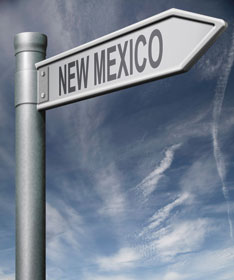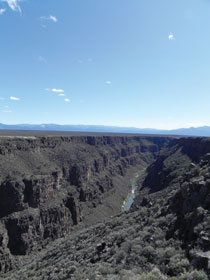Although the oil and gas industry in New Mexico is booming—as it is in the rest of the country—these days, Wally Drangmeister calls the state’s industry “a tale of two basins.”
Drangmeister, the director of communications for the New Mexico Oil and Gas Association, pointed out that there are a near-record 87 rigs operating in the Land of Enchantment at last report, most of which are drilling in Lea, Chavez, Eddy and Roosevelt, the four counties in the southeastern part of the state that are part of the oil-rich Permian Basin. The new Bone Spring play has added to the flurry of activity in the southeastern New Mexico.
There are only five rigs operating in the northwest corner of the state, however. The San Juan Basin in the Farmington area in northwestern New Mexico has traditionally produced natural gas. But low natural gas prices, coupled with logistical difficulties caused by the state’s pit rule and the now-repealed greenhouse gas rule, left operators in the San Juan Basin hesitant to drill, according to Karin Foster, executive director of the Independent Petroleum Association of New Mexico.
But that may be changing. Foster said those attending a recent industry meeting for the Four Corners region of the state left with more optimism than they have had in the last couple of years. Although drilling hasn’t really started, companies have been leasing up land in anticipation of an emerging Mancos oil shale play in the southern part of the San Juan Basin.
Drangmeister and Foster, as well as an independent operator, a driller, and a lobbyist, were asked to weigh in on the oil and gas industry’s “State of the State” in New Mexico. Despite the industry going “steady and strong,” as one described it, there are still a number of critical issues facing the oil and gas industry in New Mexico, including the state’s unique pit rule, water issues, threats to hydraulic fracturing, and attempts to add certain indigenous wildlife species, including the Lesser Prairie Chicken, to the endangered species list.
In their backyard
The prolific activity in the southeastern part of New Mexico has not only been great for that region’s economy but it is also nice for companies like McVay Drilling and Lynx Petroleum in Hobbs and Harvard Petroleum in Roswell because they are able to work in their own backyard.
great for that region’s economy but it is also nice for companies like McVay Drilling and Lynx Petroleum in Hobbs and Harvard Petroleum in Roswell because they are able to work in their own backyard.
Chris McVay, vice president of McVay Drilling, is the fourth generation to work in his company, which will celebrate is 70th anniversary in 2014.
“We have six conventional drilling rigs,” he offered. “We primarily like to drill in our backyard. We are big in the 2nd Bone Spring with a couple of rigs and we have drilled a 3rd Bone Spring horizontal well, drilling to 10,700 feet depth and then [we] kick off 5,000- to 6,000-foot laterals. That is hard for me to comprehend. The biggest thing is to stay up with new technology. It changes day to day with downhole motors and rotary steerable bits. It is complicated. We are doing a lot of things we didn’t do 10 years ago.”
McVay Drilling was operating at 40 percent of capacity in 2008. Since early 2009, however, the company’s six rigs have been running at 100 percent capacity, according to McVay.
“The key is our employees,” he emphasized. “We had a guy get his 25-year bonus this year, and another his 30-year bonus. We take care of our employees.”
McVay added that his employees love the fact that they are drilling in southeastern New Mexico because they can go home at night and sleep in their own beds. He also pointed out that the average well used to take 40 days to drill. Now, his company can drill a well in 24 days, even when the job calls for drilling deeper and horizontally.
Larry Scott, president of Lynx Petroleum, said his company is a non-operating partner in the burgeoning Bone Spring shale play and is an operator in the Morrow, Wolfcamp, and Strawn formations in southeastern New Mexico.
“We are blessed with oil reservoirs in southeastern New Mexico,” he said, “and we are still seeing lot of activity.”
Pit Rule
Scott, past president of the Independent Petroleum Association of New Mexico, said the industry is trying to get the state’s pit rule softened.
“We would like to see the pit rule revised to more accurately reflect science and allow the use of reserve pits,” he offered. “New Mexico’s regulations are significantly harsher than Texas’.”
IPANM executive director Foster said that current estimates reveal that an operator faces costs of at least $100,000 per well to comply with the pit rule and use a closed loop system. This cost is before the cost of hauling drill cuttings to a centralized facility. In Southeast New Mexico there are three facilities but in the Northwest there is not one OCD-approved facility that can take cuttings from an oil project.
Foster said IPANM was scheduled to provide testimony to the Oil Conservation Commission in late June regarding changes in Rule 17, or “the Pit Rule.” The OCC is scheduled to deliberate the issue in July.
Currently, depending on the depths to groundwater, the New Mexico pit rule requires the permitting of a system, such as a closed loop system, to recycle and reduce water used in drilling. It also restricts the use of temporary, lined pits to locations no closer than 500 feet from groundwater, domestic wells, springs, or wetlands. Further, the rule prohibits on-site burial of low salt drilling mud, and it does not allow off-site burials of waste from more than one location.
Foster said the proposed amendments would reduce or remove the permitting requirements for closed-loop systems, clarifying that notification of the use of a closed loop system would be required for drilling operations only, and would allow for burial in place of pits with groundwater greater than 100 feet from the bottom of the pit, allowing for siting of drilling pits up to 100 feet from domestic wells, or continuously flowing watercourses, redefine low chlorides as 15,000 mg/liter or less for siting and closure purposes, and make standard one pit for multiple wells.
“In addition, the OCC has the authority to protect the environment and human health, but not livestock,” she added. “There is part of an industry proposal that IPANM opposes that will require operators to prove to an OCD staffer that an exception to the rule would be more protective to livestock than the existing rule. We are fighting that because we want a rule that is easy to understand and to follow, not one that is based on how often company guys have to beg a regulator for an exception.”
New regulations
Drangmeister said the NMOGA worked with the Oil Conservation Commission on new horizontal drilling rules and new hydraulic fracturing disclosure rules, as well as proposed changes to the pit rule.
“We put forth the hydraulic fracturing rule and the pit rules, and both sides put together the horizontal drilling rule,” he stated. “We wanted to use Frac Focus in our disclosure rule, but they put in a state database. But in general, it is a positive development. We have pushed for regulations that are good for the industry and protective of the environment.”
He said the industry was successful is getting the repeal of the state’s greenhouse gas and cap-and-trade regulations this year. Until the repeal, New Mexico was the only state other than California to have air emission standards that were stricter that the federal regulations imposed by the Environmental Protection Agency.
Endangered species
Texas and New Mexico industry officials were thrilled to finally receive the long-awaited decision June 13 from U.S. Fish and Wildlife and the Department of the Interior that it would not put the Dune Sagebrush Lizard on the endangered species list.
The industry had fought this for months because it could greatly hamper drilling activity in both southeastern New Mexico and far West Texas, two areas that are certainly key contributors to the recent boom in the Permian Basin.
“I want to co-exist with the lizard,” McVay offered.
In making the announcement, federal officials said they expect state governments in Texas and New Mexico, landowners and energy producers to carry through on their states’ respective plans to conserve and restore the lizard’s habitat. If not, the U.S. Fish and Wildlife Service can always move to list the lizard as an endangered species again.
Congressman Mike Conaway, a Republican from Midland, said, in a statement, “I am hopeful that in the future Fish and Wildlife will look first to negotiate voluntary agreements with local communities rather than dictate blanket orders from Washington.”
Another issue of concern to operators in the Permian has to be the uncertainty surrounding potential species listing decisions by the Department of the Interior and the U.S Fish and Wildlife Service. “Several companies have been approached by the BLM to sign candidate conservation agreements with the promse that if a company signs, then permits will still be processed even if a species has habitat in the company’s development area,” Foster said.
Drangmeister said that the state land office in New Mexico has committed to enroll state lands in the conservation agreement program and that individual operators have also agreed to pay a negotiated price per acre along with providing active restoration at the rate of two acres for every acre impacted by oil and gas operations. But Foster is concerned that the BLM may be using the good will of industry as a means to increase funding at a time when agency budgets are facing cuts. “The multiple pending lawsuits and settlement agreements made between this administration and the environmental community, with industry involvement, is disconcerting,” she said.
Hydraulic fracturing
Mike Miller, a lobbyist whose firm Professional Directions represents the Permian Basin Petroleum Association in Santa Fe, claimed things have gotten better since the election of Gov. Susana Martinez.
“She has been respectful of the industry,” Miller contended, “and she expects the industry to be good neighbors, to do the right thing. But I don’t believe she will allow any over-the-top thing to get past her desk.”
When the New Mexico legislature convenes next year, the industry, he said, will have to be prepared to defend hydraulic fracturing, which, of course, has been a critical component in the industry’s recent boom.
“San Miguel County has passed an ordinance banning hydraulic fracturing,” Miller stated, “and I have been told that there is a group that will try to introduce some sort of legislation to reduce hydraulic fracturing in the state. If it is something that makes sense, like the disclosure bill they passed in Texas, the industry will not likely be opposed to it. The industry is not opposed to good sound rules, regulations, and laws. But sometimes in New Mexico, we throw the baby out with the bath water. Santa Fe is an interesting place. They have a lot of ideas like [those in] the foreign country of California.”
“If they outlaw fracking, that will shut down our industry,” McVay lamented. “The ability to frac makes it more attractive. It is a big part of our industry. This will be one of the biggest fights.”
Scott said the industry has been using hydraulic fracturing in the state for the last 60 years with limited environmental issues. Now, however, some environmental groups have raised red flags concerning hydraulic fracturing, although, as Scott said, “the opposition hasn’t gotten a lot of traction.”
Because New Mexico has so much federal land, the NMOGA is watching what the BLM might do concerning implementing federal regulation of hydraulic fracturing on federal lands, Drangmeister said.
Meanwhile, the PBPA Regulatory Committee is developing comments on this proposal and will be submitting them to the agency in July.
“Hopefully, the BLM will keep it on the state level,” Drangmeister said. “Hopefully, through the legislative process, they will look at our good safety record.”
New legislature
Unlike Texas, the legislature in New Mexico meets ever year. But on even-numbered years, it meets for only 30 days and can consider items of a fiscal nature only, according to Miller. He said the legislature meets for 60 days in odd-number years, and then “everything is fair game.” That will be the case in the 2013 legislative session.
“When the legislature meets in January, it will have different look,” Miller continued. “How different, I don’t know. The Speaker of the House is not running for re-election, so I know we will have a new speaker. Last year, we had 35 Democrats, 34 Republicans, and one Independent in the House. Sometimes, gridlock is not a bad thing.”
Miller emphasized that the industry has to stay alert not only to fight bills that would hurt the industry but also to defend beneficial legislation.
“We need to make sure that decisions are based on science and fact, not emotion,” he added. “We got our CO2 emission and California style cap-and-trade regulation repealed because they didn’t make scientific sense.”
Water issues
In looking at long-range issues, Scott of Lynx Petroleum is concerned about water.
“An issue coming down the road is water supply,” he said. “Horizontal drilling and multi-stage fracs have caused the industry to use more water because most of the stimulation is with fresh water. It is getting to be more expensive. I see potential problems because we don’t have multi-thousand-acre lakes in this part of the world.”
“Fresh water is a more valuable resource,” said McVay, agreeing with Scott. “It is hard to justify using thousands of barrels of water for hydraulic fracturing when folks in Midland can’t water their yards. That is pretty controversial. We have to figure out how to clean up frac water for re-use. That is a billion-dollar issue. There are a lot of issues to face, and every one is important.”
Importance to the state budget
The bottom line, according to Miller, is that the state of the industry in New Mexico is in a state of flux.
“Southeastern New Mexico has been incredibly productive in what it has provided to the economy and to state revenues,” he said, “especially since the natural gas-driven revenues are down in northwestern New Mexico. Thank goodness oil production is filling the gap, or the state government would be in serious trouble.”
Miller explained that the state budget was based on projections of future/ongoing gas prices and crude oil prices, but the dollar figures that were used in these assumptions have long since been rendered inaccurate, due to some extreme price fluctuations. Natural gas is selling as much as $3 per Mcf less than the State of New Mexico budgeted, while crude oil has been selling at $30 or $40 more than the state budgeted.
“The rule of thumb is that a fluctuation of a dime in Mcf price means $12 to $14 million to the state budget in New Mexico,” he pointed out, “but a fluctuation of $1 in oil prices means $4 million to $8 million to the state. A lot of the legislators recognize the contribution our industry makes to education and the state’s general fund. That is my job, to educate the legislature on what our industry means to the state. We want to be partners in keeping New Mexico the Land of Enchantment without over-regulation or over-legislation.”












